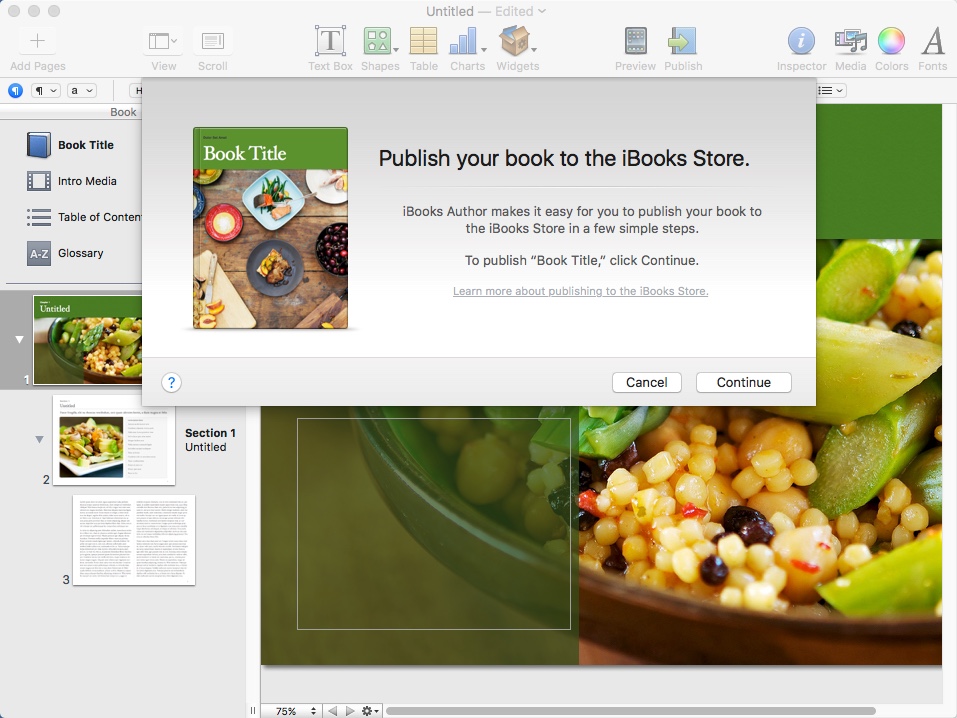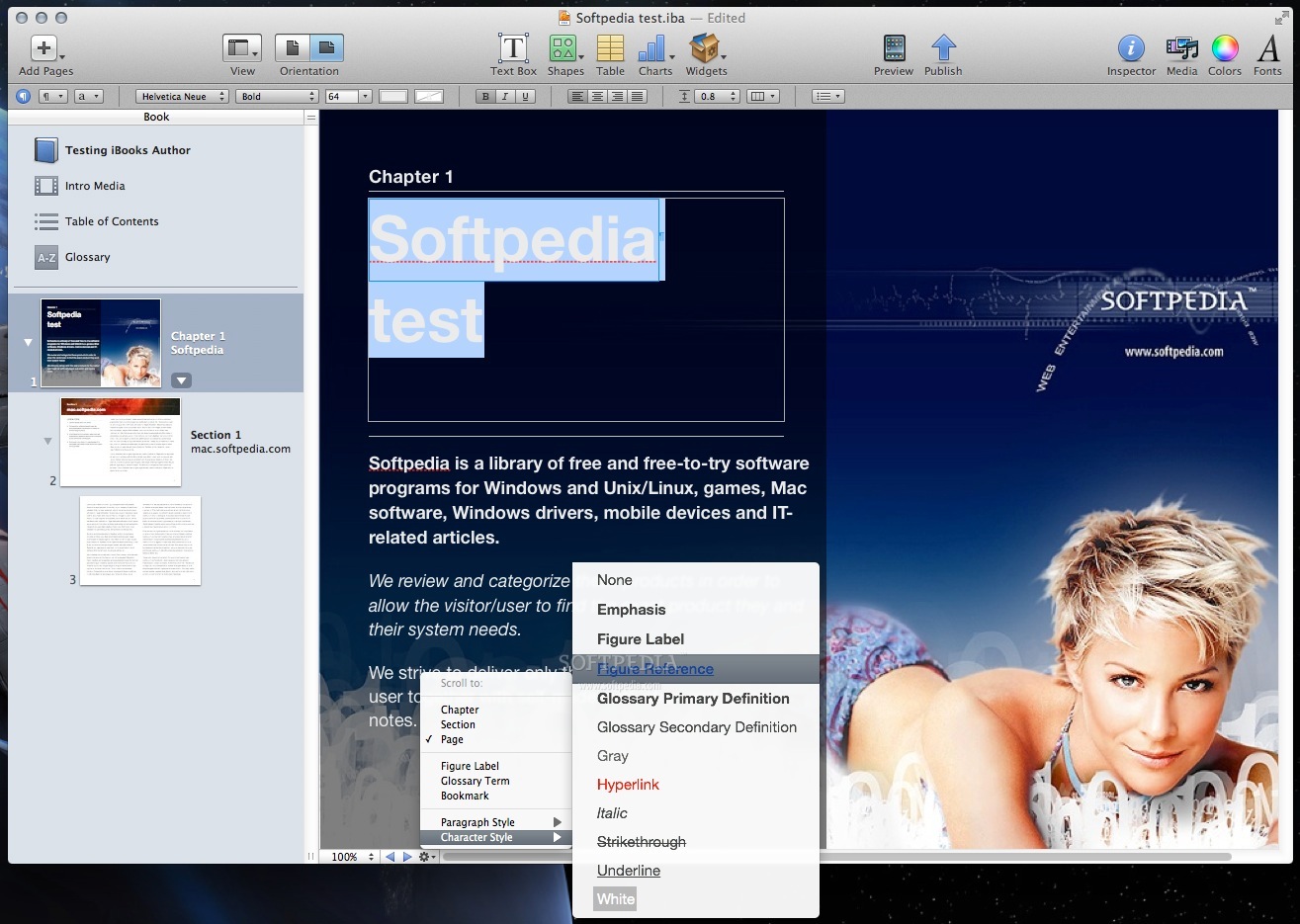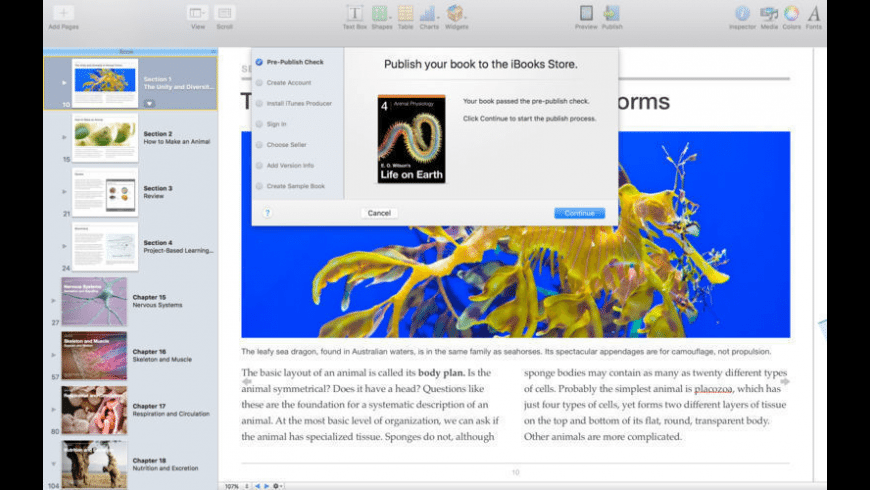Ibooks Author 2.3 Dmg

While there was only about three minutes of the October 23, 2012 Apple event dedicated to iBooks and the updates to iBooks and iBooks Author (you can watch those three minutes on CNET here ), it was enough to create a stir in the #ePrdctn/eBook creator community. Here is an a collection of responses I have found so far.
Portrait Templates iBooks Author Edition / Designs and Graphics / 131072 KB / Graphics and Design / DeeDa Designs ☆ Portrait Templates iBooks Author Edition vers 1.2 Portrait Templates iBooks A (dmg) how download vers 1.2 portrait templates ibooks author edition on MacBook Air. Download ibooks author 2.0 for free. Productivity downloads - iBooks Author by Apple, Inc. And many more programs are available for instant and free download. Apple released iBooks Author 2.3 Tuesday, an update that allows the software to make ebooks that can be read on an iPhone. The company did so. In a book made using iBooks Author, you can link from an HTML widget to another place within the same book, or you can link to an EPUB (.epub) book or to another Multi-Touch (.ibooks) book. When linking to a Multi-Touch book, you can link to a specific location, such as a figure, chapter, section, or page number.
iBooks
At The Digital Reader, Nate Hoffelder (@thDigitalReader) posted “iBooks 3.0 Wasn’t Nearly the Update I Expected.” In some ways it is a post-event response to his optimistic pre-event post “iBooks 3.0 Coming Next Week – Adds More Support for Epub3.” The bottom line is that Hoffelder is disappointed in the update. The positives include:
But at least this app does have access to new dictionaries for German, Spanish, French, Japanese and Simplified Chinese (iOS6 required). And the app can now receive free updates to purchased ebooks – including new chapters, corrections, and other improvements. There are also new sharing options (the usual Facebook, Twitter, email, Messages).
Baldur Bjarnason has also added this bit of information in the comments (which are worth reading):
They seem to have focused more on adding features for iBooks Author/multi-touch ebooks than for EPUB3.
For example, as far as I can tell, MathML does actually work, as long as the book is an iBooks Author book.
This is the first version that actually supports FXL rendition metadata as specified by the IDPF.
Baldur Bjarnason (@fakebaldur) has been tweeting the results of his tests on iBooks 3.0. It particular, he is listing what markup and CSS works and does not work in iBooks 3.0. Here is some of what he posted:
Damn. iBooks Author 2.0 looks awesome. Font embedding is automagical.
iBooks Author has become so good that it makes you really want to ignore the downsides (proprietary, limited market, only one store, etc.)
[iBooks format] It’s forked epub that is incompatible with every epub reader out there except ibooks. It *isn’t* epub.
I don’t think that’s the major issue for me. iBA books only work in ibooks. No other reader will support them, no matter what.
I *love* the continuous scrolling setting in iBooks.
“Being burned is a mere physical change, like the burning of a stick of wood, if it is not perceived as a consequence of some other action.”

That tweet just now is from John Dewey’s “Democracy and Education”. iBooks notes sharing seems to work nicely.
iBooks doesn’t make it easy to add author or title to the tweeted note, though.
Emailing notes from iBooks en masse is easy and works nicely. Preserves context but not formatting (italics and bold lost).
Two things missing from ereaders: 1. OPML export of notes. 2. The ability to embed highlights+notes into the epub file itself, PDF-style.
I *hate* the garish faux-book cartoon parody that iBooks uses. I can live with almost any weirdness to be rid of it.
Because OPML is the de facto interchange format for Outliner apps. Every major outliner supports it.
I’m not talking about using OPML as an archival format but as an interchange format for bringing material into a writing env.
Exporting the hightlights and the notes as OPML would be an *incredibly* useful feature for writers.
It doesn’t look like iBooks supports mixing FXL and reflowable pages like the EPUB3 FXL spec allows.
It doesn’t support bitmaps or SVG in spine either. Most of the rest seems to work.
IMO iBooks 3.0 doesn’t come close to supporting the full EPUB3+FXL specs. Big parts of the spec still missing.
Also, the differences in CSS rendering between iBook 3.0’s book/full-screen views and the scrolling view are a bit worrying.

As in, CSS rendering in iBook’s scrolling view behaves a lot more like it would in a web browser.
The only question in my mind that remains is what features Apple has implemented behind proprietary display-options.xml toggles.
The good news is that regular reflowable EPUB3 files in iBooks now seem to support absolute positioning.
Adding a rendition:spread = none meta property turns off the annoying fake book skeuomorphism in FXL EPUBs in iBooks.
overflow: scroll in FXL epubs in iBooks doesn’t work if you set it on body or html. Have to wrap the content in a div and set it on that.
The good new is that -webkit-overflow-scrolling: touch; works in FXL epubs
This was a highlight tweeted straight from iBookshttps://twitter.com/fakebaldur/status/261043659754065920 … It doesn’t seem to add author or title automatically.
Ibooks Author 2.3 Dmg Free
Long highlights are truncated to fit 140 chars.
Email sharing works well. Haven’t tried facebook sharing as I don’t use facebook.
You highlight and sharing pops up as an option. Sharing old highlights works as well.
Yeah. I would have thought that attribution would be an important part of sharing a quote.
The rendition:orientation property seems to work in FXL books as it should.
iBooks doesn’t seem to support varying page sizes (differing viewport sizes) in FXL documents as the spec seems to allow.
EPUB3 Bindings don’t seem to work in iBooks either.
oeb-page-head and oeb-page-foot don’t work.
page-progression direction rtl seems to work. And vertical writing.
iBooks using an EPUB3 FXL file. Apple FXL files have no spec as afar as I know, just documentation.
Definitely looks like iBooks doesn’t support epub:switch.
MathML works in my tests but it isn’t working for some. iBooks is clearly intent on maintaining its reputation as a buggy mess.
Update: As we had all hoped, Baldur Bjarnason has written up his response to the iBooks 3.0 update in his post “iBooks 3.0.”
Walrus Books has a review with videos on their post “IBooks 3.0: THE TEST OF MORSE.” It is written in French, but Google Translate through Chrome will give you the just of the post. There are also a couple of Vimeo videos embedded to show you how iBooks works. The upshot:
To summarize: new design, new ergonomics, including through the use of this mode Scroll abolishing border roll (volumen) and codex, both of which now live. A good thing in a world where on the screen, everyone reads by scrolling. Walrus in, we believe it is a necessary and a real gain for reading on screen. Hoping that readers adopt. Do not forget to activate it via the menu iBooks. [Blame in on the Google Translation.]
Read Write has posted “Apple’s Slow But Radical Overhaul of Education,” which focuses more on how Apple is positioning itself to capture the secondary education market, though it does have this to say about the updates:
The next wave of that impact won’t come from iBooks 3 or the new version of iBooks Author, which are both nice, but relatively minor updates. If anything from Tuesday’s event will help push digital textbook adoption forward, it’s the hardware.
You can see a whole list of other sites that mention the iBooks announcement here, but most just talk just reiterate what Tim Cook said during the event.
iBooks Author
On YouTube, the Bookkry (thebookry) has posted the video “A look at the new iBooks Author 2 layouts and widgets” that goes through these new features. The video covers new layout templates that are portrait only, LaTex and MathML support, scrolling sidebar and pop-up widgets.
Mashable has a post by Samantha Murphy “Apple Reinforces Education Push with iBooks Author Update.” The highlight is
Now, publishers can add mathematical expressions into digital textbooks and access multi-task widgets. This will help keep students up to date with the latest educational content when updates become available. Apple also detailed new areas of customization such as personalizing fonts.
Here are some additional articles that mention the iBooks Author update, again, many just repeating what Tim Cook said in the announcement.
What is your reaction to the updated iBooks and iBooks Author? Are they big improvements? Are there other reviews worth sharing?
Ibooks Author 2.3 Dmg Download
But the apps can still be useful in find new design ideas, as well as showing just how much iBooks Author templates can be customized by a creative and talented designer
The Apple eBook publishing platform iBooks Author has had its critics since its first launch, but it has also its fans. Those who work with the platform like it for the same reasons many like working with other Apple apps: it is easy to learn and consistent with other Apple programs such as Pages.

iBooks Author itself is on version 2.4. For a program first released in January of 2012, it has not had many updates. But then again, the program, with one exception, has always been stable – and the big problems with iBA are kind of baked in and hard to fix.
The only faulty update released was version 2.1 which introduced previewing new eBooks on the Mac. An error took place, corrected with the version 2.1.1 update, where the ability to embed custom fonts was temporarily lost.
It took a while, but Apple finally added iPhone support with the version 2.3 update last June, though designing something interesting for the iPhone remains challenging.
While iBA may be easy to work with, creating a truly stunning eBook for the iPad and Mac is still a matter of the publisher’s design skills. Many of the early eBooks released looked very much like the early templates Apple supplied with the program itself. To help novice designers out, a few developers launched template apps for iBA – some free, some costing $9.99 or more.
Are these template programs worth buying? It really all depends on your skill level as a designer, and how comfortable one feels customizing a template. The real value of these apps is for getting ideas that you can apply yourself, rather than finding a perfect template that requires no customization.
There are a couple of free template apps, which you might want to check out first before paying for others.
Ibooks Author 2.3 Dmg File
Templates for iBooks Author Free was just updated this month, adding 30 new templates. But all the themes here are in portrait, and a link inside the program takes you to Themes for iBooks Author, which was also recently updated, but costs $19.99, the most expensive add-on out there.
Another, Designs for iBooks Author, has not been updated since 2013.
Among the $9.99 apps is Template Bundle for iBooks Author, which has some good ideas in it, and Cookbook Templates iBooks Author Edition, which was recently updated to fix some bugs and add two new templates.
$9.99 and up feels like a lot of money to spend on an app these days, but really it is nothing if the goal is to improve your eBook. But the real value of these template apps is to remind designers what makes a good design.
One thing one notices right away is that the artwork in these templates is often gorgeous – far better than the artwork many novice designers end up using. So once one deletes the placeholder graphic with the one that will be used the look of the eBook suddenly declines. The lesson is obvious: make sure you have good, high resolution artwork.
The other thing that one also notices is that the artwork in these templates tend to be used very large. It is something I have struggled with on occasion. Rather than using one good photo I might use many poorer quality photos. Bad idea. Better to go bigger, maybe full screen, rather that trying to fit in multiple photos.
But when examining these template apps one sees a sameness to the templates. These apps, it appears, are all designed by one hand, rather than multiple designers. That means the variation between themes is minimal, a good reason to make sure you look at all the template apps and their screenshots rather than just one or two.
In the end, the two most important things about working with iBooks Author is feeling comfortable customizing templates yourself, and stealing borrowing ideas.
Customizing iBA is easy enough, but my only real advice is to constantly duplicate your work so you can go back to compare your designs as you move along with any project.
As far as getting good ideas, the real best place to do this isn’t really these template apps but eBooks that have made it into the iBooks Store. Unfortunately, Apple has not made this easy. Back in 2012, Apple created a special place inside the iBooks Store for eBooks made using iBA. Sadly, they eliminated this a couple of years ago and now one must go category by category to find interactive eBooks built using iBA. It was almost as if Eddy Cue was attempting to undermine the software team.
But there are a couple tricks you can use to make discovery a little easier: first, look for book covers that are slightly shorter than the others, these sometimes will mean iBA was used, but not always; second, look at the screenshots, they are the dead giveaway.
It is especially interesting to look at two versions of the same title: one built using iBA and found inside the iBooks Store, and the Kindle edition inside Amazon.com.
An example of this would be West Point History of World War II, Vol. 1, from the The United States Military Academy. The iBooks version costs $29.99 and is interactive. The Kindle edition is $41.99 and lacks the features of the iBA version. Leaving the pricing out of the comparison, the two books show the advantages of iBA in a pretty clear manner.